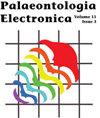Taxonomic utility of Early Cretaceous Australian plesiosaurian vertebrae
IF 1.5
4区 地球科学
Q1 Earth and Planetary Sciences
引用次数: 0
Abstract
Despite their broad occurrence in Australian basins, lower-level taxonomy of Australian Early Cretaceous plesiosaurs is hindered by the scarcity of skulls and other diagnostic elements. This paper presents a morphological and morphometric analysis of the vertebrae of Australian plesiosaurs and a comparison with selected non-Australian elasmosaurids (basal elasmosaurs, styxosaurines, aristonectines). Biometric analysis involved measurements that include centrum height (CH), centrum width (CW), centrum length (CL), width of zygapophyses, and others. Principal component analysis (PCA) and multivariate analysis of variance (MANOVA) were carried out on CH, CW, and CL. Morphometric ratios [Vertebral Length Index (VLI), Height Index (HI), and Breadth Index (BI)] were plotted along the length of the vertebral column and on bivariate graphs where the analysis is independent of vertebral position and correct sequencing. Direct comparison of homologous groups of vertebrae (especially anterior cervicals) easily distinguished an Australian polycotylid from all elasmosaurids in all plots. Most Australian elasmosaurid specimens plotted near basal ‘Cimoliasaurus’grade elasmosaurs, where they clustered as a group relatively distinct from, but overlapping coeval non-Australian forms. However, one specimen plotted consistently with the non-Australian styxosaurines and Opallionectes andamookaensis plotted with the aristonectines. Although it is not possible to distinguish phylogenetic relationships from morphological convergence in the plotted positions, the analyses provide potential hypotheses to be tested with additional data. Hence, vertebrae have some taxonomic value for potential assignment of Australian plesiosaurs, even in the absence of skulls or other diagnostic material. Vikram Vakil. School of Earth and Environmental Sciences, University of Queensland, Brisbane St. Lucia, QLD 4072 Australia. vikram.vakil@uqconnect.edu.au Prof. Gregory Webb. School of Earth and Environmental Sciences, University of Queensland, Brisbane St. Lucia, QLD 4072 Australia. g.webb@uq.edu.au Dr. Alex Cook. School of Earth and Environmental Sciences, University of Queensland, Brisbane St. Lucia, QLD 4072 Australia. alex.cook@y7mail.com早白垩纪澳大利亚蛇颈龙脊椎的分类实用性
尽管澳大利亚早白垩世蛇颈龙广泛分布于澳大利亚盆地,但由于头骨和其他诊断元素的稀缺,澳大利亚早白垩纪蛇颈龙的较低级别分类学受到阻碍。本文对澳大利亚蛇颈龙的脊椎进行了形态学和形态计量学分析,并将其与选定的非澳大利亚雷龙类(基底雷龙类、冥龙类、马齿龙类)进行了比较。生物特征分析包括椎体高度(CH)、椎体宽度(CW)、椎体长度(CL)、关节突宽度等测量。对CH、CW和CL进行主成分分析(PCA)和多变量方差分析(MANOVA)。形态计量比[椎骨长度指数(VLI)、高度指数(HI)和宽度指数(BI)]沿脊柱长度绘制,并绘制在双变量图上,其中分析与椎骨位置和正确测序无关。直接比较同源的脊椎群(尤其是颈前路),可以很容易地将澳大利亚的多节龙与所有的elasmosaurids区分开来。大多数澳大利亚elasmosaurid标本绘制在基底的“Cimoliasaurus”级elasmosaur附近,它们聚集在一个与同时代的非澳大利亚形态相对不同但重叠的群体中。然而,有一个标本与非澳大利亚的styxosaurines和Opallionectes andamookaensis一致,与aristonectines一致。尽管在绘制的位置上不可能区分系统发育关系和形态学收敛,但分析提供了潜在的假设,需要用额外的数据进行检验。因此,即使在没有头骨或其他诊断材料的情况下,脊椎对澳大利亚蛇颈龙的潜在分类也有一定的价值。Vikram Vakil。昆士兰大学地球与环境科学学院,布里斯班圣卢西亚,澳大利亚昆士兰州4072。vikram.vakil@uqconnect.edu.auGregory Webb教授。昆士兰大学地球与环境科学学院,布里斯班圣卢西亚,澳大利亚昆士兰州4072。g.webb@uq.edu.au亚历克斯·库克博士。昆士兰大学地球与环境科学学院,布里斯班圣卢西亚,澳大利亚昆士兰州4072。alex.cook@y7mail.com
本文章由计算机程序翻译,如有差异,请以英文原文为准。
求助全文
约1分钟内获得全文
求助全文
来源期刊

Palaeontologia Electronica
地学-古生物学
CiteScore
3.60
自引率
0.00%
发文量
20
审稿时长
>12 weeks
期刊介绍:
Founded in 1997, Palaeontologia Electronica (PE) is the longest running open-access, peer-reviewed electronic journal and covers all aspects of palaeontology. PE uses an external double-blind peer review system for all manuscripts. Copyright of scientific papers is held by one of the three sponsoring professional societies at the author''s choice. Reviews, commentaries, and other material is placed in the public domain. PE papers comply with regulations for taxonomic nomenclature established in the International Code of Zoological Nomenclature and the International Code of Nomenclature for Algae, Fungi, and Plants.
 求助内容:
求助内容: 应助结果提醒方式:
应助结果提醒方式:


